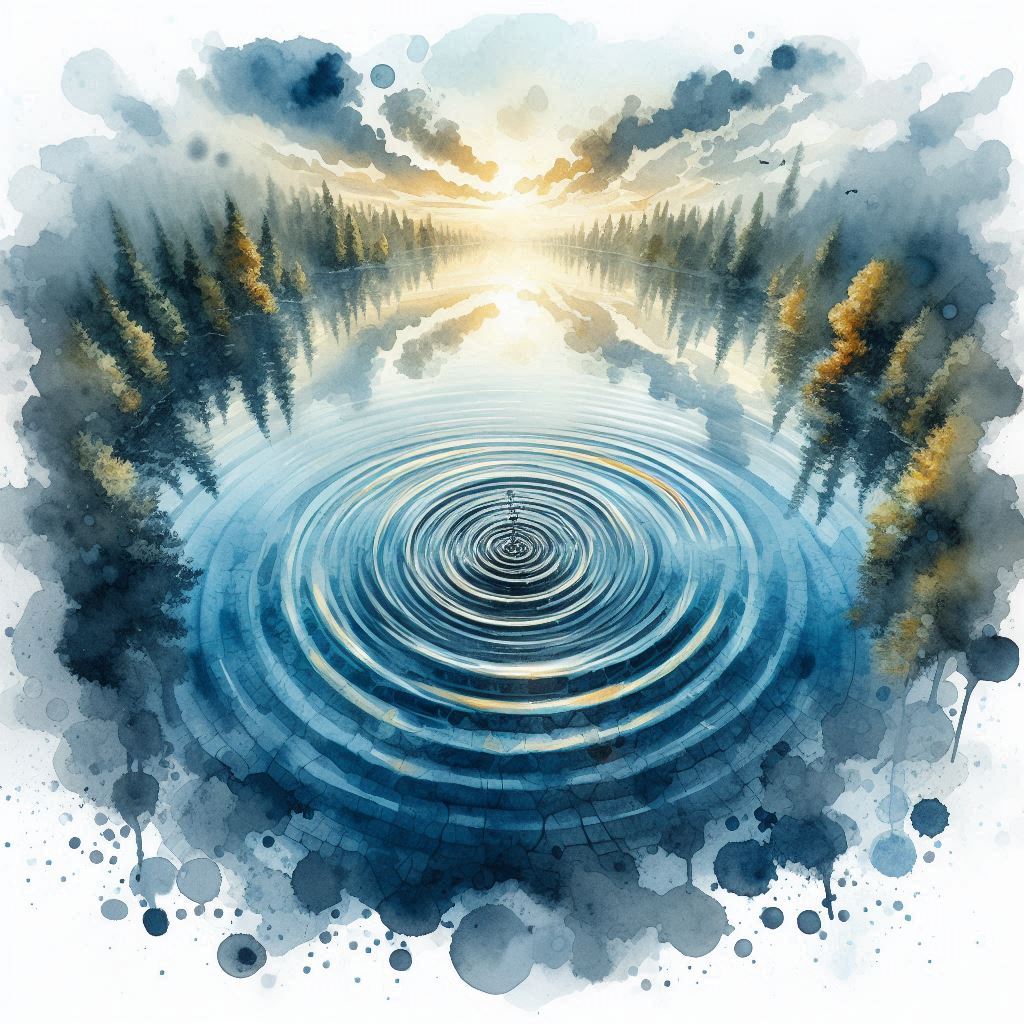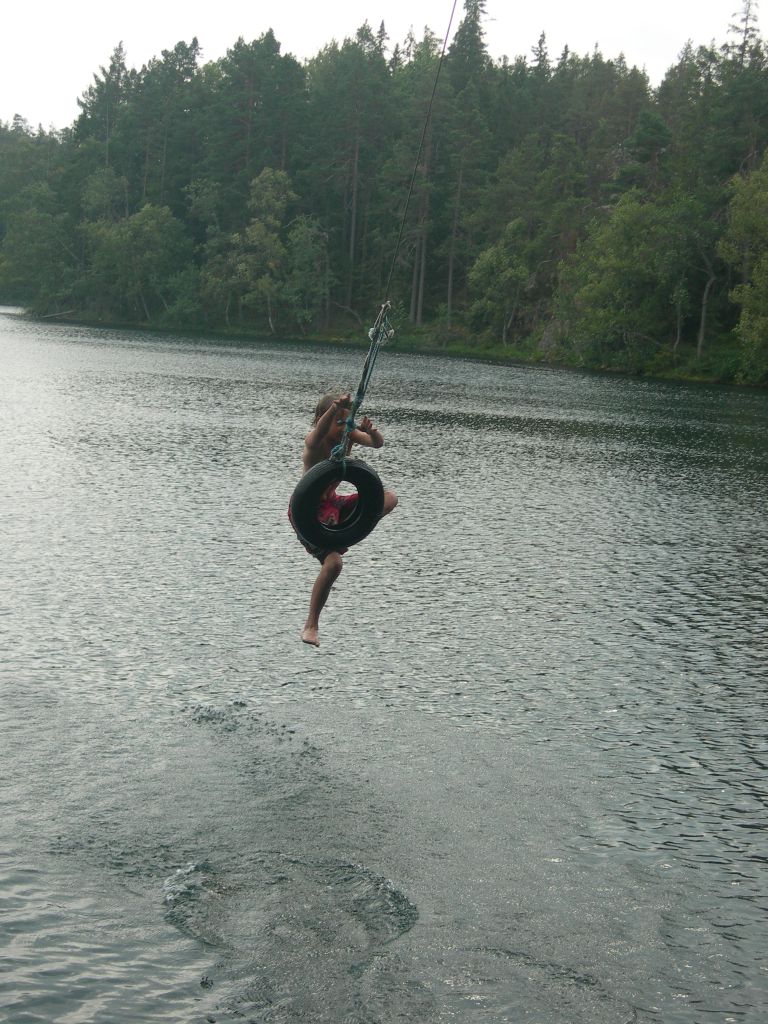Image above by Kevin from The Beginning at Last

Freedom to Roam Everywhere
When I was a kid, I used to roam around a lot, in the forest and on the mountains, and I liked to swim and fish in the rivers and the famous deep lakes in the Swedish countryside. Sweden has 97,500 lakes larger than 2 acres and many of them are deep lakes with clean and clear water surrounded by forests, typically coniferous forests. A small deep clean forest lake is referred to as a “tjärn”. I can add that there are no alligators or venomous water snakes in Swedish lakes.
Sweden offers a type of freedom that is rare in the world, and it does not exist in the United States and certainly not in Texas where I live. It is the freedom to roam or more specifically allemansrätten. Whether the land is public or private you have the right to roam, to hike, to camp, to swim, to pick wild berries, to pick wild mushrooms, to fish, and no one can stop you. Landowners are not allowed to tell you to get off their land and they cannot put up fences to stop you or animals from roaming on their land. Everyone has the right to roam and swim everywhere. It is a freedom Swedes love, and if you one day come to experience it you will know why.

Allemansrätten
The Swedish freedom to roam or allemansrätten, is a right for all people to travel over private land in nature, to temporarily stay there and, for example, pick wild berries, mushrooms, flowers and certain other plants. It is important to point out that you must respect the landowner’s property. You can pick wild berries but not anything the landowner is growing. You cannot destroy or break things or start fires, use ATVs, cut branches off trees, etc. You also need to stay 70 meters or 230 feet away from any dwelling.
As a landowner in Sweden, you can buy land and use it for farming and forestry, and you have the right to prevent people from damaging or stealing your crops. You can buy land for mining, and you have the right to your proceeds and the right to prevent people from stealing from your mines. In addition, people don’t have the right to get close to your house. However, you do not have the right to prevent anyone from roaming on your land.
Other countries with similar laws are Norway, Finland and Iceland. Limited forms of allemansrätten exist in Austria, Germany, Estonia, France, the Czeck Republic, and Switzerland. In the United States, where allemansrätten does not exist, 63% of all land is private and in Texas 93% of all land is private. Since there is no law in the US protecting your freedom to roam there is noticeably something missing, especially if you are an outdoors person.
Concentric Circles
In addition to evoking my memories of Swedish lakes and allemansrätten, Kevin’s picture tickles my mathematical sense, specifically regarding concentric circles. Concentric circles are beautiful, dreamy, and interesting mathematical phenomena. I could watch concentric circles in the water all day long.
When you jump and play in a lake, when raindrops fall on a lake or a pond you’ll see concentric circles. You see concentric circles on a tree stumps, when you cut an onion, some flower petals, spiderwebs, etc. Concentric circles are everywhere in nature. Light can create concentric circles due to diffraction called an airy disk. Gravitational waves originating from, for example, two black holes colliding create 3D gravitational concentric circles/spheres traveling at the speed of light through space.
Concentric circles are very common in nature. You can see them in Kevin’s picture above. You can see them below my son as he falls into the Swedish lake, and you can see them in the pictures of light below. Whenever waves originate at a point and spread outward you get concentric circles.
There are many kinds of waves, water waves, sound waves, surface waves, seismic waves (earthquakes), mechanical waves, light are waves, electromagnetic waves, matter is both particles and waves, gravitational waves, and they can all make concentric circles. If the waves are moving outward with the same velocity in all directions, you will get equidistant concentric circles.




Hugely interesting to hear that the Swede’s are so liberal on that front too.
LikeLiked by 1 person
Politics aside, this rule is one that I benefitted from a lot as a kid and as a teenager. I love nature and I spent a lot of my time in the forests, lakes and rivers, the sea, islands, the north Swedish archepelago, mountains, and I certainly made a lot of concentric circles in various bodies of water.
LikeLike
I’ve always been fascinated by concentric circles and spirals, both of which appear in nature. Great post, Thomas.
LikeLiked by 1 person
Yes me too. Thank you very much Alex.
LikeLiked by 1 person
Hi Thomas, this is most interesting. England has a form of this as there are public paths and common land. In South Africa, private land is private. I think a lot of fencing in and stopping public access to areas has to do with crime and theft. These are high in SA and in the USA. Maybe, Sweden is different in that regard although I’ve read crime is on the increase there.
LikeLiked by 1 person
Yes I read about England but as I understand it is quite limited compared to the Swedish/Norwegian law. You are probably right. If there is a high risk of home invasions and destruction of property than landowners want to fence themselves in. In fact, in Sweden they’ve had problems with foreigners taking advantage of the rule by using special tools to pick wild berries very efficiently and often destroying the bushes in the process. Then they go sell the berries in markets. They come to Sweden only to make money off the free berries in the forests. However, they have addressed the issue.
LikeLike
HI Thomas, I am pleased to know the issue has been addressed in Sweden.
LikeLiked by 1 person
I had no idea about the land laws in Sweden. That is quite fascinating, and yes, quite different from the laws here! It sounds like when it works, it works beautifully.
Patterns are also quite fascinating. They can be almost hypnotic in a way.
Thank you for another highly informative and interesting post, Thomas! Most greatly appreciated!
LikeLiked by 1 person
Thank you so much Kevin. Yes this law allowed me to make lots of concentric circles in rivers, lakes, and by the north Swedish archipelago (thousands of islands).
LikeLike
I love the idea of allemansrätten, Thomas. What a generous and respectful way to ensure that everyone can enjoy the beauty of nature. It makes me want to visit Sweden and its neighbors. That certainly isn’t something you find in the US. I’m lucky that in Oregon, the coastline is protected for all to enjoy, but that kind of access is rare. The current destruction of the US National Park system is going to make getting out into nature a lot harder.
LikeLiked by 1 person
Thank you Diana, you are right. I think that allemansrätten is responsible for Swedes being so much into nature and being outdoors people. Almost everyone loves to hike, camp, swim in lakes, visit islands, fish, and do boating because it is easy and you can do it almost everywhere. You just go. I spent maybe 80% of awake freetime out in nature. Most landowners love it themselves because it allows them to do the same.
LikeLiked by 1 person
That is how life should be. I’m entranced.
LikeLiked by 1 person
I admit I had a fun childhood
LikeLiked by 1 person
🙂 🙂 I love that.
LikeLiked by 1 person
Very interesting Thomas. I didn’t know Sweden’s trespassing laws were so liberal. Here in Canada we fall somewhere in the middle. You cannot trespass on private land, and if you do, the owner can only use reasonable force to remove you if necessary. Most people aren’t too concerned about trespassers unless they are causing property damage. A lot of our land is Crown land. It has environmental rules but is generally open to explore. Maggie
LikeLiked by 1 person
Thank you Maggie, that is interesting information. Canada certainly have a lot of land. I’ve only visited Toronto but I would like to see more of Canada. Sweden’s allemansrätten certainly allows everyone to be an outdoors person with ease. I think pretty much all Swedes are outdoors people.
LikeLike
That is interesting. I hadn’t heard of that. A limit to private ownership. I wonder what happens if someone is injured traveling your property. Can they sue you? Or is that law your defense? I’d have to get used to it.
LikeLiked by 1 person
Thank you, Jacqui. That is a good question, and I am not sure of the answer. However, I believe that you cannot sue for two reasons. Like you say it is the law that makes private land accessible, that is not the landowner’s problem or responsibility. Secondly Sweden does not allow as many lawsuits. It is a lot less litigious than the US. I know a lot of people who have gotten hurt on private land, but I have never heard of a lawsuit. I should say that typically Swedish landowners love the allemansrätten themselves. However, I have heard of foreign landowners who bought land without knowing about it who complained.
LikeLiked by 1 person
Interesting. I think of the American Indians who believe no one owns the land. They didn’t understand buying-selling it. But they were territorial, protecting their home lands. Not sure how that all fits it! Thanks for an interesting concept.
LikeLiked by 1 person
I’ve read about that too but I don’t think they are connected (but I don’t know). Allemansrätten came into existence at the end of the 1930’s and was a continuation of hundreds of years of unofficial practice. I don’t think Swedes in the 19th century knew anything about Native Americans. As for territorial I believe that is quite universal. Sweden and Denmark fought 11 wars over territory. But those are interesting questions. How does different culture/ways of viewing things develop.
LikeLiked by 1 person
That’s very interesting. I don’t think most countries would allow visitors in private property. And it takes very friendly people to be okay with that as respect between the owners and those visiting the property is necessary.
LikeLiked by 1 person
Yes, it is only a handful of countries, mostly the nordic or north European countries that have similar laws. Norway and Sweden stand out. You are right, respect goes both ways. If a lot of people start disrespecting the landowners it wouldn’t work.
LikeLiked by 1 person
This is so cool, Thomas. Reminds me a lot of sacred geometry as well. I love that image. Oh, and the picture of your son on the tire swing is everything! 😊
LikeLiked by 1 person
Thank you so much for your kind words Laura. I’ve made lots of concentric circles in lakes and rivers in northern Sweden.
LikeLike
I like the thought of how accommodating the land owners are to let people just roam around on their property. I just can’t see it working here at all. Too much violence, and the mind set of shoot first, ask questions later. I’m glad it works in Sweden and other countries though.
Very interesting about the circle patterns, and to know they are everywhere, even in space. 🙂
LikeLiked by 1 person
Yes you are right Barbara. I certainly can see a big difference. Allemansrätten allowed me to roam, hike, fish, swim, visit hundreds of islands I picked randomly, and go pretty much everywhere any time, when I was a kid and a teenager. Nature everywhere was for everyone and I took advantage of it, and I made lots of concentric circles in the water. When I didn’t have a lot of homework I went out into the forests and stayed there until late evening. I am a nature loving person. However, as you say it goes both ways. Landowners privacy and property has to be respected or the law does not work.
LikeLiked by 1 person
How lovely to be able to roam at will, and not encounter “No Trespassing” signs or menacing land owners! You come from a more genteel culture, Thomas. Sadly, this wouldn’t work so well in North America. 🥺
Love the image of your son – so joyful! 😃 The diffracted light patterns are mesmerizing. 😍
LikeLiked by 1 person
Thank you so much Debbie. We had a good time with that tire swing over that little forest lake. We’ve been back there as a familay a few times.
LikeLiked by 1 person
What heartwarming childhood memories, Thomas. I imagine that “allemansrätten” is one of those words that can’t translate exactly into English.
LikeLiked by 1 person
Yes, roaming just as you like on the north Swedish country side was special. They typically translate “allemansrätten” to “freedom to roam”, but direct translation from old Swedish is really “all human’s right”
LikeLiked by 1 person
Thank you, Thomas, for this beautiful word: allemansrätten. And this excellent post. So much food for the imagination here.
LikeLiked by 2 people
Thank you so much Stacey. They typically translate “allemansrätten” to “freedom to roam”, but direct translation is really “all human’s right”.
LikeLiked by 1 person
Sweden sounds amazing Thomas. Makes me wonder why you’d want to leave. 🙂
LikeLiked by 1 person
Both countries are good countries but in different ways. However, the reason I left Sweden was my wife. We lived in Sweden for a while and she was not happy with the cold and the darkness in winter. I can imagine that people used to warmer climates have the same issues with Canada. The company I was working for at the time, ABB Robotics, had/have departments all around the world and they moved us around.
LikeLiked by 1 person
Okay, I totally understand. The lack of sunshine surely affects me too. 🙂
LikeLiked by 1 person
Yes the lack of sun in winter in northern latitudes is difficult for some people.
LikeLiked by 1 person
Here in Arizona, we have free-range cattle who can roam wherever they want in the winter. I dread having these massive creatures with horns in my yard every year. Last year, they split my old cherry tree in half. They stand in the dark in the middle of the road and cause accidents. They are gentle, to be sure, and can easily be driven off, but property owners have no recourse for any damage done. Since they come looking for water, we put big tubs out by the driveway so they don’t need to come too far onto our property. Although the roaming laws sound wonderful in other countries, people only come onto private property in my neighborhood if they are looking for trouble.
LikeLiked by 1 person
Yes I can understand that. It does not work everywhere. It was good idea about with big tubs of water. I should add that in Sweden the cattle is usually fenced in with electrical wires. The cows don’t have the same right as people. Moose on the other hand, go everywhere, and they cause damage to neighborhoods.
LikeLike
Java Bean: “Our Dada claims that when he was growing up in rural New York, he was free to roam just about anywhere in the village ― out in the woods, down to the creek, across the road to the railroad tracks, whatever! But he and Mama don’t even let me out in the front yard without a leash, so I do not think I believe him.”
LikeLiked by 1 person
I think there should be a free to roam rule for all dogs, at least at the dog park and the backyard. As for the rest of the land in the world, Dada is just worried about you getting into trouble. He probably never got into trouble.
LikeLike
Nope, never. That’s my story and I’m sticking to it.
LikeLiked by 1 person
Ha ha that is wonderful and the total truthiness
LikeLike